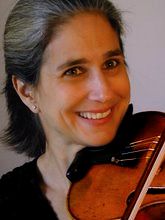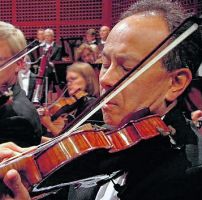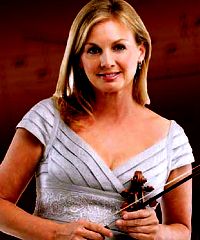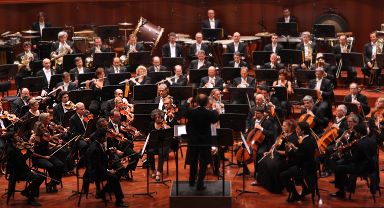| CONSTANCE MEYER Articles |
|
Second violinists are first-class musicians
Supporting the first violinist in an orchestra or a chamber group requires 'a different kind of virtuosity,' but no less proficiency. May 17, 2009 | by Constance Meyer | The Los Angeles Times
Not every concertgoer realizes that the sea of violins in a symphony orchestra consists of two distinct sections. Likewise, there are two violins in a string quartet. In both cases, the first violins generally "knock out the high melodies," as Smiley puts it, while the second violins handle the accompaniment. Take Verdi's operas or Tchaikovsky's ballets. While the first violins play the themes that people go out of the theater humming, the second violins most often provide the oom-pah-pahs. "Playing second fiddle" may connote being second best, but the preparation for playing first or second violin is exactly the same. "You learn concertos and the brilliant, virtuosic stuff," Smiley explains.
"There may be a second violin mentality," Dicterow says, "but I am not aware of it. My father would sometimes make jokes that they never go out of first position" -- the fingering that beginning violinists start with -- "but that is not true. Actually, most orchestral repertoire has extremely difficult second violin material. Zubin Mehta considered my father one of the truly great orchestral section leaders."
On the other hand, Dicterow says that although all violinists auditioning for the New York Philharmonic prepare a first violin part, "violinists hired by major orchestras usually go directly into the second violin section. Our string sections have rotation, so all second violinists actually end up playing in the firsts at some point during every season -- all except the frozen players, who sit on the first two stands of the seconds." If there are vacancies in the first section in the N.Y. Philharmonic, there are always "in-house" auditions first. Only if no one from within the orchestra is chosen is a vacancy advertised and open to outsiders. Where to sit?
No 'virtuosos' One observation occurs more than any other from musicians who play second violin full time, and that's their sense of the music as a whole. A second violinist in a major American orchestra who preferred to remain anonymous put it this way: "The orchestra is not the place for virtuosity. In fact, often the 'virtuosos' can be the problem in certain musical situations. Blending is everything." And second violinists seem utterly attuned to the orchestra as a single entity and to their contribution to it. "I think you have to subsume yourself into the whole," Smiley says. "When we have a long accompanying passage that's repetitive, that could become monotonous, I listen to whoever has the melody, and even though I may be playing off-beats, in my mind I'm playing the melody. "It's a very thrilling feeling to feel wired into this mega, gigantic string organism. It's not always the most glamorous, but it's very heartfelt -- it's the soul of music-making at that level," he says. "When you're playing the second violin part, you can see the textures, the almost brocade-like tapestry."
|
|
|
Copyright 2009 Constance Meyer. All rights reserved
|
|
|
|
|
|
|
|
|
|
|

 Dan Nobuhiko Smiley
is principal second violinist for the San Francisco Symphony. He laughs at his title: "Sounds like an oxymoron. How can you be a principal and second at the same time?"
Dan Nobuhiko Smiley
is principal second violinist for the San Francisco Symphony. He laughs at his title: "Sounds like an oxymoron. How can you be a principal and second at the same time?"
 According to
According to
 In all symphony orchestras, the location of the first violin section is set in stone: It is always on the conductor's left. And the most common placement of the second violins fits with their "lesser-than" status:
They're buried behind the first violins and the cello section is placed directly opposite the first violins. In this configuration, the second violins sit next to the violas -- which, considering that these two sections constitute the "inner" voices,
means that their being sandwiched between the treble and bass is helpful.
In all symphony orchestras, the location of the first violin section is set in stone: It is always on the conductor's left. And the most common placement of the second violins fits with their "lesser-than" status:
They're buried behind the first violins and the cello section is placed directly opposite the first violins. In this configuration, the second violins sit next to the violas -- which, considering that these two sections constitute the "inner" voices,
means that their being sandwiched between the treble and bass is helpful.